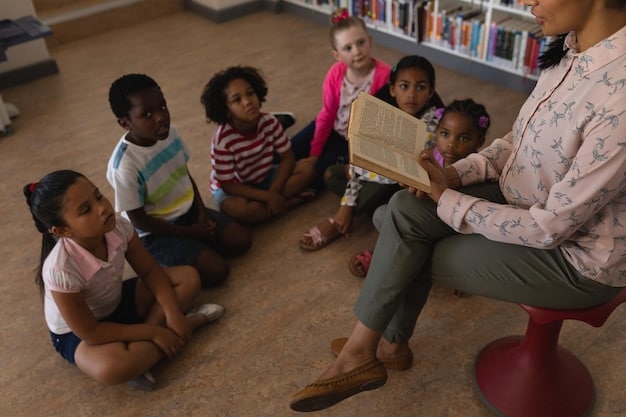Understanding Learning Disabilities: Identification & Support Strategies

Anúncios
Navigating the complexities of learning disabilities requires a profound understanding of their diverse manifestations, presenting a critical need for structured identification and tailored support strategies to foster academic and personal growth.
Anúncios
Understanding the Different Types of Learning Disabilities: Identification and Support Strategies is crucial for educators, parents, and individuals alike. These conditions, which impact how a person learns, retains, and uses information, are not indicative of intelligence but rather reflect unique neurological wiring. Recognizing the signs early and implementing effective strategies can profoundly change an individual’s educational journey and overall life trajectory.
Understanding the Landscape of Learning Disabilities
Learning disabilities, often misunderstood, are neurological conditions that affect the brain’s ability to receive, process, analyze, or store information. These differences can make it challenging for individuals to learn as quickly or in the same way as their peers, particularly in academic settings. It is vital to emphasize that learning disabilities are not a sign of low intelligence; many individuals with learning disabilities possess average or above-average intellectual capabilities.
The term “learning disability” itself is broad, encompassing various specific conditions. Each type presents unique challenges and requires distinct approaches to identification and support. Without a clear understanding of these distinctions, efforts to assist affected individuals may fall short, leading to frustration and underachievement.
Anúncios
Defining Learning Disabilities: Beyond Stereotypes
Moving past common misconceptions, a learning disability primarily refers to a significant discrepancy between an individual’s intellectual potential and their actual academic achievement. This discrepancy is often observed in specific areas such as reading, writing, or mathematics, rather than a global intellectual deficit. The challenges faced are intrinsic to the individual, not merely a result of poor instruction or lack of motivation.
- Neurological Basis: Learning disabilities stem from differences in brain structure or function, impacting how information is processed.
- Persistent Nature: These conditions are generally lifelong, though their impact can be mitigated with appropriate interventions.
- Specific Impact: They typically affect specific academic skills rather than general intelligence.
Effective support begins with dispelling stereotypes and embracing a neuro-inclusive perspective. Recognizing that learning differences are variations in cognitive processing, rather than deficits, opens the door to more respectful and effective intervention strategies.
Ultimately, a comprehensive understanding of what constitutes a learning disability, and equally important, what it does not, forms the bedrock for creating supportive educational environments and empowering affected individuals to thrive. It requires a commitment to ongoing learning and adaptability from all stakeholders.
Specific Types of Learning Disabilities: A Closer Look
While the term learning disability is a general umbrella, several specific disorders fall under this classification, each with distinct characteristics and challenges. Understanding these specific types is crucial for accurate diagnosis and the implementation of targeted interventions. Misdiagnosis or a lack of understanding can lead to ineffective support and missed opportunities for academic success.
Dyslexia: Decoding the Written Word
Dyslexia is perhaps one of the most widely recognized learning disabilities, primarily affecting reading and language processing. Individuals with dyslexia often struggle with phonological awareness, which is the ability to recognize and manipulate the sounds in language. This can manifest as difficulty with:
- Accurate and fluent word recognition: Struggling to quickly and correctly identify words.
- Poor spelling: Frequent errors in spelling due to difficulties associating sounds with letters.
- Decoding abilities: Trouble breaking words down into their individual sounds.
- Reading comprehension: Understanding what has been read, even if they can technically read the words.
Dyslexia is not about seeing letters backward, as commonly believed; it’s a neurological condition that affects how the brain processes language. Early identification and multi-sensory approaches, such as Orton-Gillingham methods, are often highly effective in helping individuals with dyslexia develop stronger reading skills.
Dysgraphia: The Challenges of Written Expression
Dysgraphia impacts an individual’s ability to write. This learning disability can affect various aspects of written expression, from physical handwriting to the organization of thoughts on paper. It often goes beyond simply having “bad handwriting” and reflects deeper difficulties in the motor skills involved in writing and the cognitive processes related to forming coherent text.
Challenges associated with dysgraphia can include:
- Messy or illegible handwriting: Despite effort, written work may be difficult to read.
- Inconsistent spacing, sizing, and alignment of letters: Letters may appear haphazardly placed on the page.
- Difficulty with fine motor skills for writing: Holding a pencil correctly or exerting appropriate pressure.
- Trouble organizing thoughts onto paper: Structuring sentences, paragraphs, and essays coherently.
Support for dysgraphia often involves adaptive tools like word processors, specialized handwriting programs, and explicit instruction in organizing written thoughts. Recognizing dysgraphia helps in differentiating it from mere sloppiness, leading to more empathetic and effective interventions.
Dyscalculia: Navigating Numerical Concepts
Dyscalculia is a specific learning disability that affects a person’s ability to understand and work with numbers and mathematical concepts. It is sometimes referred to as “math dyslexia,” though it’s a distinct condition. Individuals with dyscalculia may struggle with fundamental arithmetic, number sense, and even abstract mathematical reasoning.
Common difficulties for those with dyscalculia include:
- Understanding number quantities and values: Difficulty grasping whether one number is larger or smaller than another.
- Basic arithmetic operations: Struggling with addition, subtraction, multiplication, and division.
- Memorizing math facts: Inability to recall basic math facts quickly.
- Understanding time and money: Challenges with telling time, managing finances, or estimating costs.
Interventions for dyscalculia often involve concrete manipulatives, visual aids, and explicit instruction on number relationships and problem-solving strategies. Patience and a breakdown of complex concepts into smaller, manageable steps are key.
These specific learning disabilities often co-occur, meaning an individual might experience challenges in multiple areas. A comprehensive assessment is therefore critical to identify all present difficulties and tailor a multi-faceted support plan.
Early Identification: Recognizing the Signs
Early identification of learning disabilities is paramount, as timely intervention can significantly improve outcomes. While every child develops at their own pace, consistent patterns of difficulty in certain areas, particularly when compared to peers, can signal the presence of a learning disability. It is important for parents and educators to be vigilant but also avoid jumping to conclusions without professional assessment.
Developmental milestones provide a general framework, but persistent struggles beyond these typical ranges warrant further investigation. These indicators are not diagnostic on their own but serve as red flags that suggest a child might benefit from a closer look by specialists. Addressing concerns early provides the best opportunity for effective support and prevents cumulative learning deficits.
Preschool and Kindergarten Indicators
Even before formal schooling begins, certain signs might indicate a predisposition to a learning disability. These early indicators are often subtle and can easily be dismissed as typical developmental variations, but a keen observer can spot patterns.
- Late talking: Significant delays in developing speech and language skills.
- Difficulty with rhymes: Trouble recognizing rhyming words or engaging in rhyming games.
- Problems with memory: Struggling to remember simple sequences like days of the week or ABCs.
- Trouble with fine motor skills: Difficulty with tasks like buttoning clothes, holding a crayon, or using scissors.
- Difficulty following directions: Inability to understand or recall multi-step instructions.
If several of these signs are present and persistent, it’s advisable to consult with a pediatrician or an early childhood development specialist. Early intervention programs can lay a critical foundation.

School-Age Indicators (Elementary and Middle School)
As children enter and progress through formal schooling, the academic demands highlight areas where learning differences may emerge more clearly. Persistent struggles across various subjects and tasks become more apparent. It’s not just about academic performance but also about the effort expended versus the results achieved.
- Reading difficulties: Slow reading pace, guessing words, or poor comprehension.
- Writing challenges: Poor spelling, messy handwriting, or inability to organize thoughts into written form.
- Math struggles: Difficulty with basic calculations, understanding concepts, or solving word problems.
- Organizational issues: Trouble managing homework, keeping track of belongings, or planning tasks.
- Social-emotional impacts: Frustration, low self-esteem, or anxiety due to academic struggles.
Educators often observe these signs in the classroom, and their collaboration with parents is key to initiating the assessment process. A comprehensive evaluation by psychologists and educational specialists is typically required for a formal diagnosis. This assessment goes beyond academic performance and delves into cognitive processing to pinpoint specific areas of difficulty. The insights gained from such assessments are invaluable for crafting individualized education plans.
The Diagnostic Process: Getting a Formal Assessment
Obtaining a formal diagnosis for a learning disability is a crucial step towards receiving appropriate support. This process typically involves a multi-disciplinary team of professionals who conduct a thorough evaluation. The goal is not just to label a child, but to understand the specific cognitive challenges they face and to inform the development of effective intervention strategies.
Who Conducts the Assessment?
A comprehensive assessment for learning disabilities is usually conducted by a team of specialists. This collaborative approach ensures that all aspects of an individual’s learning profile are considered.
- Educational Psychologists: They administer standardized tests to measure cognitive abilities, academic achievement, and information processing skills.
- Special Education Teachers: They provide observations of classroom performance, academic progress, and instructional responsiveness.
- Speech-Language Pathologists: They assess receptive and expressive language skills, which are often comorbid with learning disabilities.
- Occupational Therapists: If motor skill difficulties (like dysgraphia) are suspected, an OT may assess fine motor skills and sensory processing.
- Pediatricians or Neurologists: They rule out other medical conditions that might mimic learning disabilities.
The involvement of multiple professionals ensures a holistic picture of the individual’s strengths and weaknesses, leading to a more precise diagnosis.
Components of a Comprehensive Evaluation
A formal evaluation is not a single test but a battery of assessments designed to gather a wide range of information. This includes standardized tests, observation, and review of historical data.
- Cognitive Assessments: Measure intellectual functioning and various cognitive abilities, such as memory, attention, and processing speed.
- Academic Achievement Tests: Evaluate skills in specific areas like reading, writing, and mathematics to identify discrepancies between potential and performance.
- Processing Speed Measures: Assess how quickly an individual can perform cognitive tasks.
- Phonological Processing Tests: Specifically for dyslexia, these tests evaluate how sounds are processed in language.
- Interviews and Observations: Gathering information from parents, teachers, and observing the individual in various settings.
- Review of Records: Examining school records, medical history, and previous interventions.
The detailed report from this evaluation typically outlines the specific learning disability, its impact on education, and provides recommendations for support. It forms the basis for developing an Individualized Education Program (IEP) or a 504 Plan.
Effective Support Strategies: Tailoring Education
Once a learning disability is identified, the focus shifts to implementing effective support strategies. These strategies aim to mitigate the challenges posed by the disability, leverage the individual’s strengths, and foster an environment where they can thrive academically and personally. The cornerstone of effective support is personalization, recognizing that a one-size-fits-all approach is rarely successful.
Individualized Education Programs (IEPs) and 504 Plans
In the United States, two primary frameworks for providing educational support are the Individualized Education Program (IEP) and the 504 Plan. Both are legally mandated under federal law to ensure that students with disabilities receive the accommodations they need.
- Individualized Education Program (IEP): Developed for students who qualify for special education services under the Individuals with Disabilities Education Act (IDEA). An IEP outlines specific educational goals, services, and accommodations. It typically focuses on specialized instruction and related services to address the unique needs arising from the disability.
- 504 Plan: Falls under Section 504 of the Rehabilitation Act, which prevents discrimination based on disability. A 504 Plan provides accommodations and modifications that allow students with disabilities to access the general education curriculum. It does not typically include specialized instruction but focuses on leveling the playing field.
The choice between an IEP and a 504 Plan depends on the severity of the learning disability and the extent to which it impacts the student’s ability to learn in a general education setting. Both plans are designed to ensure students receive an appropriate education.
Classroom Accommodations and Modifications
Beyond formal plans, specific accommodations and modifications within the classroom can significantly benefit students with learning disabilities. These adjustments help create a more accessible learning environment.
- Extended time on tests and assignments: Allowing more time to process information and demonstrate knowledge.
- Reduced distractions: Seating in a quiet area or allowing the use of noise-canceling headphones.
- Use of technology: Text-to-speech software, word processors, or calculators to bypass specific difficulties.
- Multi-sensory instruction: Presenting information through visual, auditory, and kinesthetic methods.
- Chunking information: Breaking down complex tasks or large amounts of information into smaller, manageable parts.
- Providing clear instructions: Breaking down complex instructions into simpler, sequential steps and ensuring understanding.
Effective implementation of these strategies requires ongoing communication between educators, parents, and students. Regular reviews and adjustments ensure the support remains relevant and effective as the student progresses. Collaboration is key to creating a truly inclusive and supportive educational setting.
The Role of Technology and Assistive Tools
In the modern educational landscape, technology plays an increasingly vital role in supporting individuals with learning disabilities. Assistive technologies (AT) can bridge learning gaps, enhance accessibility, and empower students to overcome specific challenges that stem from their learning differences. These tools are not a substitute for robust instruction but rather powerful aids that can level the playing field.
Empowering Learning Through Digital Aids
Digital tools offer a wide array of functionalities that directly address common difficulties associated with learning disabilities. From converting text to speech for those with reading challenges to providing organizational support, technology can significantly enhance an individual’s capacity to learn and demonstrate knowledge. The rapid evolution of technology continues to expand the possibilities, offering more sophisticated and personalized solutions.
- Text-to-Speech (TTS) and Speech-to-Text (STT) Software: TTS can read digital text aloud, benefiting those with dyslexia. STT allows individuals to dictate their thoughts, aiding those with dysgraphia or writing difficulties.
- Organizational Apps and Planners: Digital calendars, reminder apps, and task managers help students with executive function challenges stay organized and manage their time effectively.
- Mind Mapping and Graphic Organizers: Software that helps visualize and structure ideas, which is especially helpful for planning essays or understanding complex concepts.
- Readability Tools: Browser extensions or software that can simplify text, adjust font sizes, or highlight text to improve comprehension and reduce visual strain.
- Specialized Calculators and Math Software: Tools that can assist with complex calculations, visualize mathematical concepts, or break down problems for individuals with dyscalculia.
The effective integration of these tools requires training for both students and educators. Understanding how to leverage these technologies can transform a student’s educational experience, fostering greater independence and confidence. It’s about finding the right tool for the right need.

Beyond specific software, general accessibility features built into operating systems and everyday devices also play a significant role. Features like adjustable font sizes, high contrast modes, and dictation capabilities are becoming standard, offering broad support to a diverse range of learners. This pervasive integration makes technology a more organic part of the learning process.
The goal of technology is not to replace human interaction or traditional learning methods but to augment them. When thoughtfully applied, assistive technology can remove barriers, allowing individuals with learning disabilities to access content, express themselves, and participate fully in their educational journey.
Advocacy and Support for Learners and Families
Navigating the world of learning disabilities extends beyond diagnosis and classroom interventions; it also involves strong advocacy and a robust support system for both the learner and their family. Understanding rights, connecting with resources, and building a supportive community are vital for long-term success and well-being.
Understanding Rights and Resources
Knowledge is power when it comes to advocating for individuals with learning disabilities. In the United States, several laws protect the rights of these individuals and mandate appropriate educational services. Familiarity with these laws empowers families to ensure their child receives the support they are entitled to.
- Individuals with Disabilities Education Act (IDEA): Guarantees a Free Appropriate Public Education (FAPE) for children with disabilities, emphasizing special education and related services through IEPs.
- Section 504 of the Rehabilitation Act: Prohibits discrimination against individuals with disabilities in programs receiving federal funds, leading to 504 Plans for accommodations.
- Americans with Disabilities Act (ADA): Ensures civil rights protections for individuals with disabilities in all areas of public life, including employment, transportation, and public accommodations.
Numerous organizations offer resources, guidance, and support networks for families. These can range from national advocacy groups to local parent support networks, providing invaluable information on navigating the educational system, understanding specific learning disabilities, and accessing services. Connecting with these resources can alleviate feelings of isolation and provide practical strategies.
Building a Supportive Community
Beyond legal frameworks, a strong support network positively impacts the journey for individuals with learning disabilities and their families. This community includes family members, educators, therapists, and other parents facing similar circumstances.
- Parent Support Groups: Offer a safe space to share experiences, gain insights, and find emotional support from others who understand the challenges.
- Professional Networks: Connecting with educational psychologists, special education advocates, and therapists can provide expert guidance and tailored advice.
- School-Home Collaboration: Maintaining open and consistent communication between parents and school staff is essential for a unified support strategy.
- Peer Support for Learners: Creating opportunities for children with learning disabilities to connect with peers who share similar experiences can foster a sense of belonging and reduce feelings of isolation.
Advocacy is an ongoing process, requiring persistence, knowledge, and a commitment to championing the individual’s needs. Empowering individuals with learning disabilities to advocate for themselves as they mature is also a critical component of building self-determination and fostering independence. The goal is to build a foundation of support that enables them to achieve their full potential.
| Key Aspect | Brief Description |
|---|---|
| 💡 Diverse Types | Dyslexia, dysgraphia, and dyscalculia are distinct learning disabilities, each requiring specific approaches. |
| 🔍 Early Identification | Recognizing early signs in preschool and elementary years is crucial for timely intervention. |
| 🛠️ Support Strategies | IEPs, 504 Plans, classroom accommodations, and assistive technology tailor education. |
| 🤝 Advocacy & Community | Empowering learners and families through rights education and supportive networks fosters long-term success. |
Frequently Asked Questions
An Individualized Education Program (IEP) is for students needing specialized instruction and related services due to a disability, qualifying under IDEA. A 504 Plan provides accommodations and modifications for students with disabilities to access general education, falling under Section 504 of the Rehabilitation Act.
Learning disabilities are neurological and lifelong conditions, meaning they cannot be “cured.” However, with appropriate identification, intervention, and support strategies, individuals can learn to manage their challenges and develop effective coping mechanisms, leading to significant academic and personal success.
While signs can appear in preschool, a formal diagnosis of a specific learning disability is typically made around age 6 or 7, when a child begins formal academic instruction. Early signs are often developmental delays, and a comprehensive assessment is crucial for an accurate diagnosis.
Attention-Deficit/Hyperactivity Disorder (ADHD) is not classified as a specific learning disability, but it can significantly impact learning. While ADHD affects attention, focus, and impulsivity, learning disabilities specifically affect the brain’s ability to process information related to academic skills. They often co-occur.
Parents play a pivotal role as advocates for their child. This involves recognizing early signs, seeking professional assessments, collaborating with educators, understanding their child’s rights, and reinforcing learning strategies at home. Active parental involvement is crucial for the child’s academic success and emotional well-being.
Conclusion
Understanding the Different Types of Learning Disabilities: Identification and Support Strategies is not merely an academic exercise; it is a fundamental pillar for fostering inclusive and effective educational environments. By shedding light on the diverse manifestations of these neurological differences, we empower educators, families, and individuals to recognize the signs early, pursue accurate diagnoses, and implement tailored strategies. The journey from initial concern to confident learning is paved with informed action, dedicated support, and a commitment to unlocking the full potential within every learner. Embracing neurodiversity through personalized approaches and robust advocacy transforms challenges into opportunities for growth, ensuring that all individuals can thrive.





